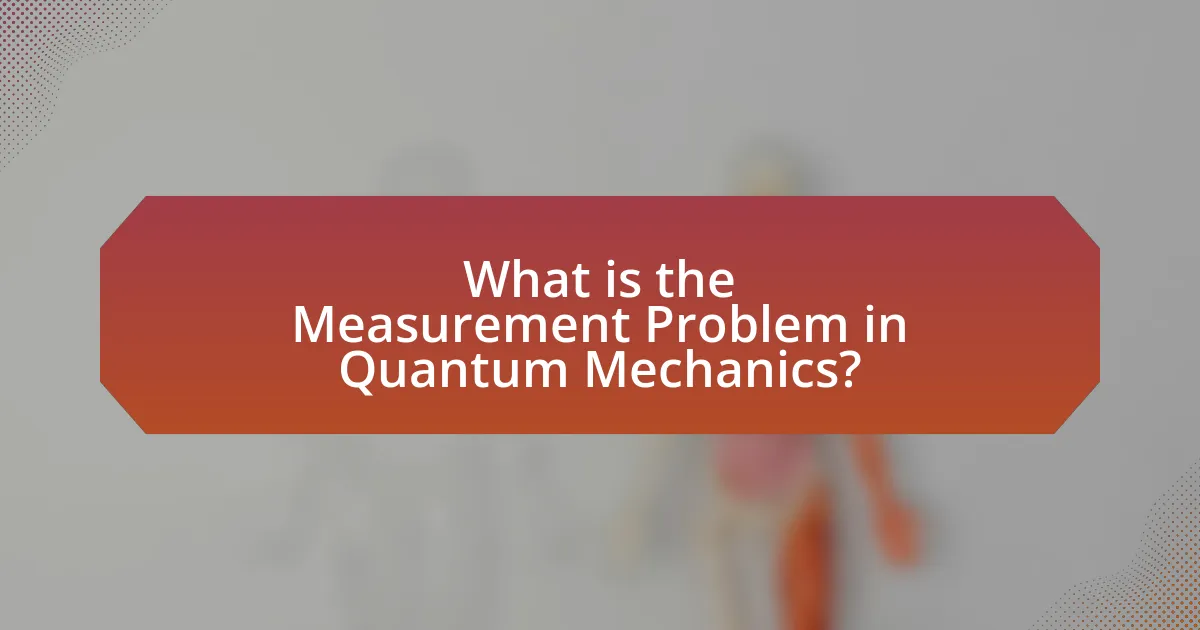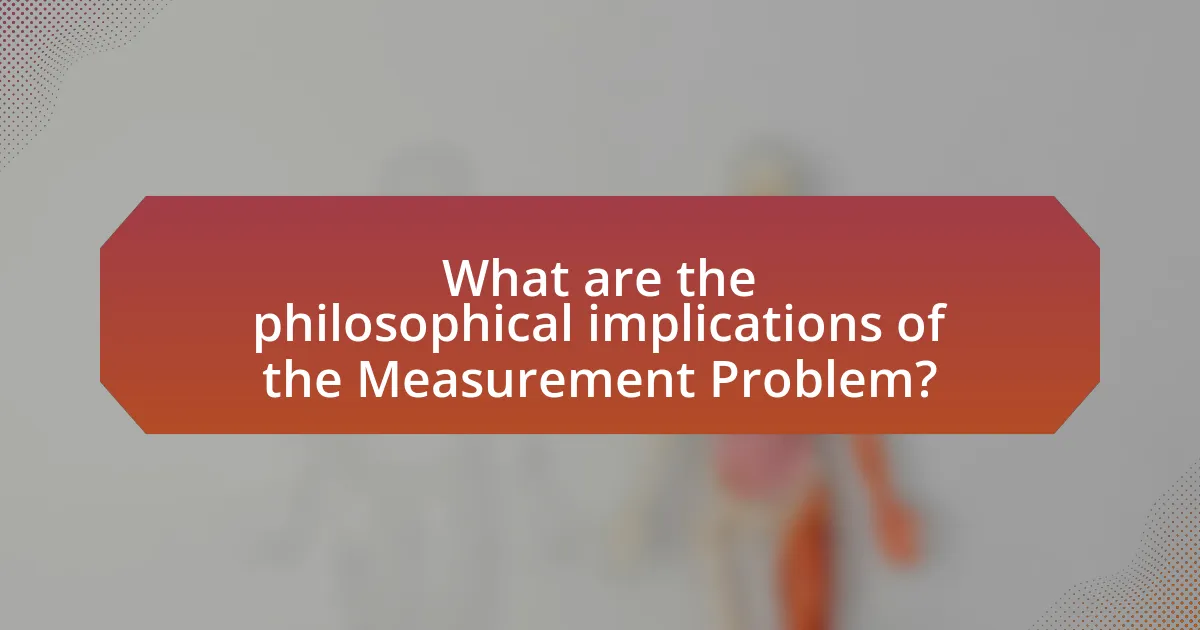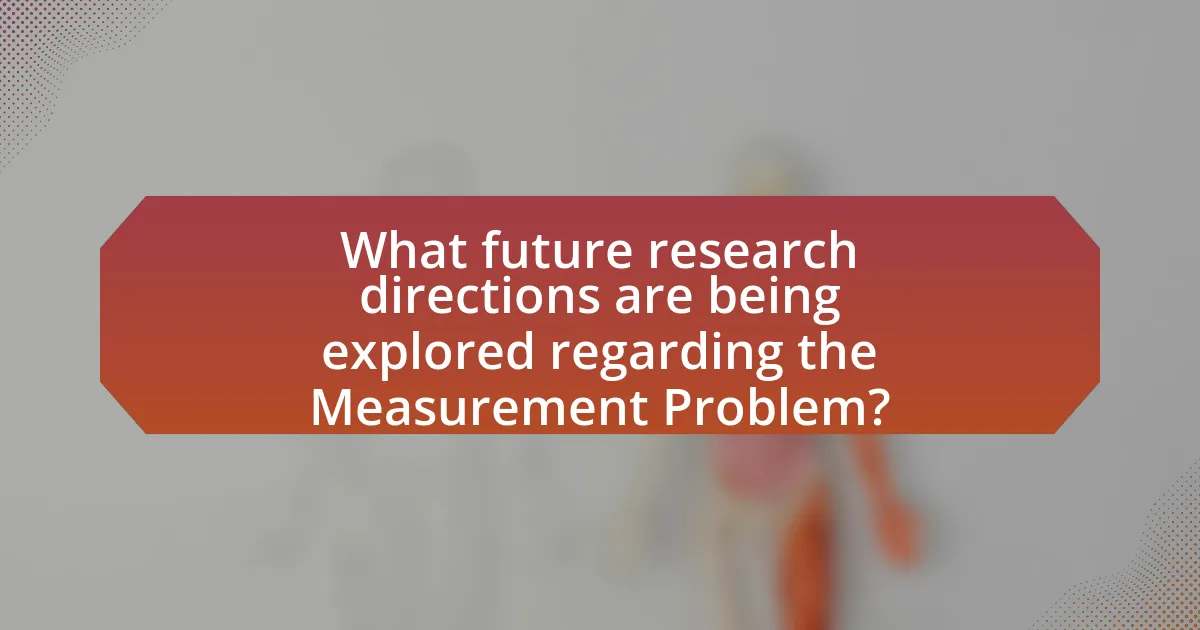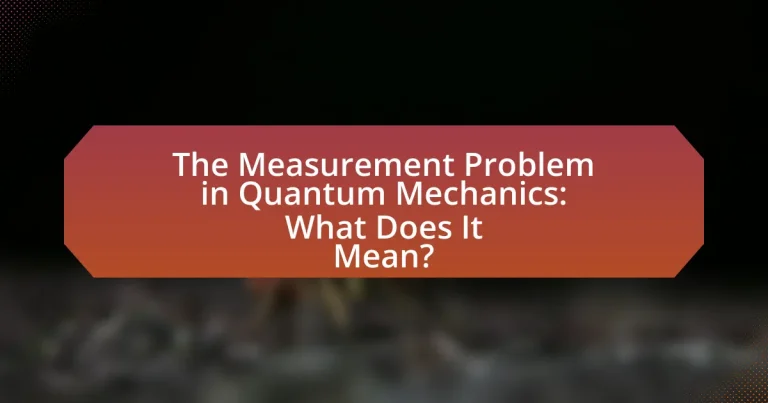The Measurement Problem in Quantum Mechanics refers to the challenge of understanding how quantum systems transition from a superposition of states to a single outcome upon measurement. This article explores the significance of the Measurement Problem, its historical context, and how it challenges classical intuitions about reality. Key concepts such as superposition, wave function collapse, and the observer effect are discussed, along with various interpretations including the Copenhagen interpretation and Many-Worlds interpretation. The implications of the Measurement Problem for quantum technologies, philosophical debates, and future research directions are also examined, highlighting its impact on our understanding of reality and the nature of observation in quantum mechanics.

What is the Measurement Problem in Quantum Mechanics?
The Measurement Problem in Quantum Mechanics refers to the challenge of understanding how quantum systems transition from a superposition of states to a single outcome upon measurement. This problem arises because quantum mechanics describes particles as existing in multiple states simultaneously until an observation is made, leading to a collapse of the wave function. The issue highlights the discrepancy between the deterministic evolution of quantum states as described by the Schrödinger equation and the probabilistic nature of measurement outcomes. This paradox has been a central topic in the interpretation of quantum mechanics, prompting various theories such as the Copenhagen interpretation and many-worlds interpretation to address the implications of measurement.
Why is the Measurement Problem significant in quantum mechanics?
The Measurement Problem is significant in quantum mechanics because it highlights the fundamental issue of how and why quantum systems transition from a superposition of states to a single outcome upon measurement. This problem challenges the interpretation of quantum mechanics, as it raises questions about the nature of reality and the role of the observer. For instance, in the double-slit experiment, particles behave as waves when unobserved, but collapse to a definite state when measured, illustrating the paradox of measurement. This phenomenon has led to various interpretations, such as the Copenhagen interpretation and many-worlds interpretation, each attempting to resolve the implications of the Measurement Problem and its impact on our understanding of quantum phenomena.
What historical context led to the development of the Measurement Problem?
The historical context that led to the development of the Measurement Problem in quantum mechanics stems from early 20th-century advancements in physics, particularly the formulation of quantum theory by Max Planck and Albert Einstein. Planck’s introduction of quantized energy levels in 1900 and Einstein’s explanation of the photoelectric effect in 1905 laid the groundwork for understanding atomic and subatomic phenomena.
As quantum mechanics evolved, particularly through the work of Niels Bohr and Werner Heisenberg in the 1920s, the concept of wave-particle duality emerged, highlighting the dual nature of particles like electrons. This duality raised questions about the role of measurement in determining a system’s state. The Copenhagen interpretation, primarily associated with Bohr and Heisenberg, posited that quantum systems exist in superpositions until measured, leading to the paradox of how measurement collapses these superpositions into definite outcomes.
The Measurement Problem specifically arose from these interpretations, as it challenges the understanding of reality in quantum mechanics, questioning how and why observations affect the state of a quantum system. This historical progression from early quantum theory to the philosophical implications of measurement illustrates the foundational issues that characterize the Measurement Problem today.
How does the Measurement Problem challenge classical intuitions?
The Measurement Problem challenges classical intuitions by demonstrating that the act of measurement in quantum mechanics fundamentally alters the state of a system, contradicting the classical view of objective reality. In classical physics, objects possess definite properties independent of observation, while quantum mechanics reveals that particles exist in superpositions of states until measured, leading to outcomes that cannot be predicted with certainty. This phenomenon is exemplified by the double-slit experiment, where particles behave as both waves and particles depending on whether they are observed, highlighting the non-intuitive nature of quantum behavior that defies classical logic.
What are the key concepts related to the Measurement Problem?
The key concepts related to the Measurement Problem in quantum mechanics include superposition, wave function collapse, and observer effect. Superposition refers to a quantum system existing in multiple states simultaneously until measured. Wave function collapse describes the transition from a superposition of states to a single outcome upon measurement. The observer effect highlights how the act of measurement influences the system being observed, altering its state. These concepts are foundational in understanding the complexities and implications of quantum measurement, as they challenge classical intuitions about reality and observation.
What is wave function collapse?
Wave function collapse is the process by which a quantum system transitions from a superposition of multiple states to a single, definite state upon measurement. This phenomenon is central to the measurement problem in quantum mechanics, as it highlights the discrepancy between the probabilistic nature of quantum states and the deterministic outcomes observed in experiments. The concept was notably discussed by physicist Eugene Wigner and is supported by the Copenhagen interpretation of quantum mechanics, which posits that the act of measurement causes the collapse, thereby determining the state of the system.
How does superposition relate to the Measurement Problem?
Superposition is a fundamental principle in quantum mechanics that states a quantum system can exist in multiple states simultaneously until measured. This principle directly relates to the Measurement Problem, which questions how and why a quantum system transitions from a superposition of states to a single outcome upon measurement. The Measurement Problem arises because, according to quantum mechanics, particles exist in a superposition of states, yet measurements yield definite results, suggesting a collapse of the wave function. This discrepancy highlights the challenge of reconciling the probabilistic nature of quantum mechanics with the deterministic outcomes observed in experiments, as seen in the famous double-slit experiment, where particles behave as waves in superposition until observed.
What are the different interpretations of the Measurement Problem?
The Measurement Problem in quantum mechanics has several interpretations, primarily including the Copenhagen interpretation, Many-Worlds interpretation, and Objective Collapse theories. The Copenhagen interpretation posits that quantum systems exist in superpositions until measured, collapsing into a definite state. The Many-Worlds interpretation suggests that all possible outcomes of a quantum measurement occur, each in a separate, branching universe. Objective Collapse theories argue that wave function collapse is a physical process triggered by certain conditions, independent of observation. Each interpretation addresses the fundamental question of how and why quantum systems transition from probabilistic states to definite outcomes, reflecting the ongoing debate in the field of quantum mechanics.
What is the Copenhagen interpretation?
The Copenhagen interpretation is a fundamental framework in quantum mechanics that posits that physical systems do not have definite properties until they are measured. This interpretation, primarily developed by Niels Bohr and Werner Heisenberg in the early 20th century, emphasizes the role of the observer in determining the state of a quantum system. It asserts that quantum mechanics can only predict probabilities of different outcomes, and the act of measurement collapses the wave function, leading to a specific outcome. This interpretation is widely accepted in the scientific community and serves as a cornerstone for understanding the measurement problem in quantum mechanics.
How does the Many-Worlds interpretation address the Measurement Problem?
The Many-Worlds interpretation addresses the Measurement Problem by positing that all possible outcomes of a quantum measurement actually occur, each in its own separate branch of the universe. This interpretation eliminates the need for wave function collapse, which is a central issue in the Measurement Problem, by suggesting that when a measurement is made, the universe splits into multiple, non-communicating branches where each possible outcome is realized. This concept is supported by the mathematical framework of quantum mechanics, which allows for superposition and entanglement, leading to the conclusion that every quantum event results in a branching of reality rather than a singular outcome.
What role does objective collapse theory play in understanding the Measurement Problem?
Objective collapse theory addresses the Measurement Problem by proposing that wave function collapse is a physical process triggered by specific conditions, rather than a mere mathematical abstraction. This theory suggests that when a quantum system interacts with a measuring device, it undergoes a spontaneous collapse to a definite state, thereby resolving the ambiguity inherent in superposition. For instance, models like the Ghirardi-Rimini-Weber (GRW) theory provide a framework where the collapse occurs randomly but with a defined probability, offering a concrete mechanism that aligns with experimental observations. This perspective helps clarify why measurements yield definite outcomes, thus providing a solution to the Measurement Problem in quantum mechanics.
How does the Measurement Problem connect to practical applications?
The Measurement Problem in quantum mechanics connects to practical applications by influencing the development of quantum technologies, such as quantum computing and quantum cryptography. This problem highlights the challenges of determining the state of a quantum system upon measurement, which directly impacts how quantum information is processed and secured. For instance, quantum computers rely on superposition and entanglement, phenomena that are fundamentally tied to the Measurement Problem; understanding these concepts is crucial for optimizing algorithms and error correction methods. Additionally, advancements in quantum cryptography, which promises secure communication, depend on resolving the Measurement Problem to ensure that the act of measurement does not compromise the integrity of the transmitted information.
What implications does the Measurement Problem have for quantum computing?
The Measurement Problem significantly impacts quantum computing by introducing challenges related to the collapse of quantum states during measurement. This issue complicates the development of reliable quantum algorithms, as the act of measuring a qubit can alter its state, leading to potential errors in computation. For instance, in quantum error correction, the Measurement Problem necessitates sophisticated techniques to ensure that qubits maintain their superposition and entanglement properties until the final measurement, which is crucial for accurate results. Thus, addressing the Measurement Problem is essential for advancing quantum computing technologies and achieving practical applications.
How does the Measurement Problem influence quantum cryptography?
The Measurement Problem significantly influences quantum cryptography by introducing uncertainty in the measurement outcomes of quantum states, which can affect the security of cryptographic protocols. In quantum cryptography, particularly in protocols like Quantum Key Distribution (QKD), the security relies on the principles of quantum mechanics, where the act of measuring a quantum state can alter its properties. This means that if an eavesdropper attempts to measure the quantum states being transmitted, the disturbance caused by the measurement can be detected by the legitimate parties, ensuring the integrity of the communication. The Measurement Problem highlights the fundamental challenge of defining the state of a quantum system prior to measurement, which is crucial for establishing secure keys in quantum cryptography.

What are the philosophical implications of the Measurement Problem?
The Measurement Problem in quantum mechanics raises significant philosophical implications regarding the nature of reality and observation. It challenges the classical notion of an objective reality independent of observation, suggesting that the act of measurement plays a crucial role in determining the state of a quantum system. This leads to debates about the role of the observer, the concept of wave function collapse, and whether reality is fundamentally probabilistic rather than deterministic. Philosophers like Niels Bohr and Werner Heisenberg have argued that quantum mechanics implies a limit to what can be known about a system, while others, such as Albert Einstein, have contested this view, advocating for an underlying reality that is not influenced by observation. The Measurement Problem thus invites ongoing inquiry into the relationship between consciousness, measurement, and the fundamental structure of the universe.
How does the Measurement Problem affect our understanding of reality?
The Measurement Problem fundamentally challenges our understanding of reality by highlighting the discrepancy between quantum mechanics and classical physics. In quantum mechanics, particles exist in superpositions of states until measured, leading to the question of how and when these states collapse into a definite outcome. This phenomenon suggests that reality is not deterministic and that observation plays a crucial role in shaping physical states. For instance, experiments like the double-slit experiment demonstrate that particles behave differently when observed, indicating that the act of measurement influences the system. This has led to various interpretations, such as the Copenhagen interpretation, which posits that reality is not fully defined until measurement occurs, thus complicating our comprehension of an objective reality.
What does the Measurement Problem suggest about determinism and free will?
The Measurement Problem in quantum mechanics suggests that determinism is challenged while free will remains ambiguous. This problem arises from the observation that quantum systems exist in superpositions until measured, leading to outcomes that cannot be predicted with certainty. For instance, the collapse of the wave function during measurement implies that the act of observation influences the state of a system, which contradicts classical deterministic views where future states are fully determined by prior conditions. Consequently, while determinism is undermined, the implications for free will are less clear, as the randomness introduced by quantum mechanics does not equate to the conscious choice associated with free will.
How do different interpretations of the Measurement Problem influence philosophical debates?
Different interpretations of the Measurement Problem significantly influence philosophical debates by shaping the understanding of reality and observation in quantum mechanics. For instance, the Copenhagen interpretation posits that quantum systems exist in superpositions until measured, leading to discussions about the role of the observer in determining reality. In contrast, the Many-Worlds interpretation suggests that all possible outcomes occur in separate branches of the universe, prompting debates about determinism and the nature of existence. These differing views affect philosophical inquiries into the nature of knowledge, the concept of reality, and the implications for free will, as each interpretation carries distinct ontological and epistemological consequences.
What are the ongoing debates surrounding the Measurement Problem?
The ongoing debates surrounding the Measurement Problem in quantum mechanics primarily focus on the interpretation of quantum states and the role of the observer in the measurement process. Key discussions include the validity of the Copenhagen interpretation, which posits that quantum systems exist in superpositions until measured, versus alternative interpretations like Many-Worlds, which suggests that all possible outcomes occur in separate, branching universes. Additionally, the implications of wave function collapse and whether it is a physical process or merely a mathematical tool are central to these debates. The lack of consensus on these interpretations highlights the foundational uncertainties in quantum mechanics, as evidenced by the continued exploration of these themes in contemporary research and philosophical discourse.
What are the main criticisms of the Copenhagen interpretation?
The main criticisms of the Copenhagen interpretation include its reliance on wave function collapse, the ambiguity surrounding measurement, and its perceived lack of realism. Critics argue that the concept of wave function collapse is not well-defined, leading to questions about the nature of reality prior to measurement. Additionally, the interpretation does not provide a clear mechanism for how measurements affect quantum systems, which raises concerns about the role of the observer. Furthermore, some physicists, such as Albert Einstein, have expressed discomfort with the idea that physical properties do not have definite values until measured, suggesting that this undermines the objective reality of quantum systems. These criticisms highlight the ongoing debate regarding the interpretation of quantum mechanics and the implications for understanding reality.
How do physicists propose to resolve the Measurement Problem?
Physicists propose to resolve the Measurement Problem primarily through interpretations of quantum mechanics, such as the Copenhagen interpretation, Many-Worlds interpretation, and objective collapse theories. The Copenhagen interpretation suggests that wave function collapse occurs upon measurement, leading to a definite outcome, while the Many-Worlds interpretation posits that all possible outcomes occur in separate, branching universes, thus eliminating the need for collapse. Objective collapse theories, like the Ghirardi-Rimini-Weber (GRW) theory, introduce mechanisms that cause wave function collapse independently of observation. These interpretations aim to address the inconsistencies between quantum mechanics and classical observations, providing frameworks for understanding how measurement affects quantum systems.

What future research directions are being explored regarding the Measurement Problem?
Future research directions regarding the Measurement Problem in quantum mechanics include exploring the implications of quantum decoherence, investigating alternative interpretations such as the many-worlds interpretation and objective collapse theories, and developing new experimental tests to distinguish between these interpretations. Quantum decoherence research focuses on how interactions with the environment can lead to the apparent collapse of the wave function, providing insights into the transition from quantum to classical behavior. Studies on the many-worlds interpretation propose that all possible outcomes of quantum measurements occur in separate, branching universes, while objective collapse theories suggest that wave function collapse is a physical process triggered by specific conditions. Experimental efforts aim to test these theories through advanced technologies, such as quantum sensors and entangled particle experiments, to provide empirical evidence that could validate or refute these interpretations.
What experimental approaches are being taken to investigate the Measurement Problem?
Experimental approaches to investigate the Measurement Problem in quantum mechanics include the use of quantum superposition and entanglement in systems like photons and atoms. Researchers conduct experiments such as the double-slit experiment, where particles exhibit wave-like behavior, demonstrating the effects of measurement on quantum states. Additionally, experiments involving weak measurements allow scientists to gather information about quantum systems without causing significant disturbance, providing insights into the nature of measurement. Notably, the work by Aharonov and Vaidman on weak values has contributed to understanding the implications of measurement in quantum mechanics. These experimental methods aim to clarify how observation affects quantum systems and the transition from quantum superposition to definite outcomes.
How might advancements in technology impact our understanding of the Measurement Problem?
Advancements in technology may enhance our understanding of the Measurement Problem by enabling more precise experiments and observations in quantum mechanics. For instance, the development of quantum sensors and improved imaging techniques allows researchers to investigate quantum states with unprecedented accuracy, potentially revealing insights into the collapse of the wave function. Historical advancements, such as the introduction of superconducting qubits and advancements in quantum computing, have already demonstrated the ability to manipulate and measure quantum systems in ways that challenge traditional interpretations of quantum mechanics. These technological improvements can lead to new theoretical frameworks and interpretations, thereby deepening our comprehension of the Measurement Problem.
What role does interdisciplinary research play in addressing the Measurement Problem?
Interdisciplinary research plays a crucial role in addressing the Measurement Problem by integrating insights from physics, philosophy, and cognitive science. This collaboration enhances the understanding of quantum mechanics and the implications of measurement, as different disciplines contribute unique perspectives and methodologies. For instance, physicists provide empirical data and theoretical frameworks, while philosophers explore the conceptual foundations and implications of measurement, such as the nature of reality and observation. Cognitive scientists can offer insights into how human perception and cognition influence the interpretation of quantum phenomena. This multifaceted approach has led to advancements in theories like decoherence and the many-worlds interpretation, which aim to resolve the Measurement Problem by explaining how quantum states transition to classical outcomes.
What practical insights can be gained from studying the Measurement Problem?
Studying the Measurement Problem in quantum mechanics provides practical insights into the nature of quantum systems and the limitations of classical interpretations. It highlights the necessity for a deeper understanding of how observations affect quantum states, which can inform the development of technologies like quantum computing and quantum cryptography. For instance, the Measurement Problem underscores the role of entanglement and superposition, essential for creating robust quantum algorithms. Additionally, it prompts discussions on the interpretation of quantum mechanics, influencing experimental designs and the formulation of new theories that could lead to advancements in fields such as materials science and information technology.
How can understanding the Measurement Problem enhance our approach to quantum technologies?
Understanding the Measurement Problem can enhance our approach to quantum technologies by providing insights into the fundamental nature of quantum states and their interactions with measurement processes. This understanding allows for the development of more robust quantum algorithms and error correction techniques, which are essential for the practical implementation of quantum computing. For instance, advancements in quantum error correction, such as the surface code, rely on a deeper comprehension of how measurement affects quantum states, enabling more reliable qubit operations. Additionally, addressing the Measurement Problem can lead to improved quantum communication protocols, as it clarifies how information is extracted from quantum systems without collapsing their states prematurely.
What best practices should researchers follow when exploring the Measurement Problem?
Researchers exploring the Measurement Problem in quantum mechanics should prioritize a clear definition of measurement and its implications within quantum theory. They must rigorously analyze existing interpretations, such as the Copenhagen interpretation and many-worlds interpretation, to understand their strengths and weaknesses. Engaging in interdisciplinary collaboration with physicists, philosophers, and mathematicians enhances the depth of analysis and fosters innovative approaches.
Additionally, researchers should employ empirical methods to test predictions made by different interpretations, thereby grounding theoretical discussions in observable phenomena. Documenting and sharing findings in peer-reviewed journals ensures that insights contribute to the broader scientific discourse. Historical context, such as the debates initiated by Einstein and Bohr, provides valuable perspectives on the evolution of thought surrounding the Measurement Problem.




